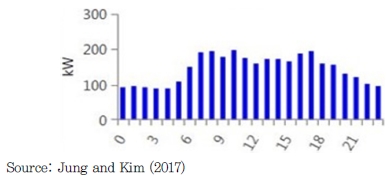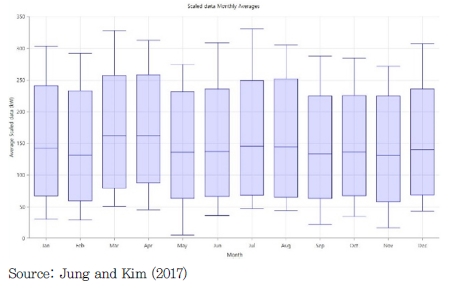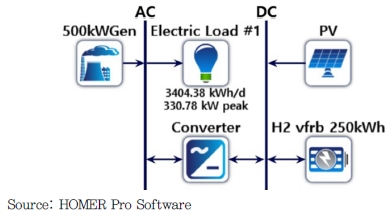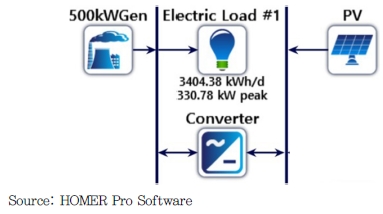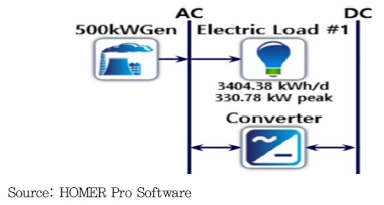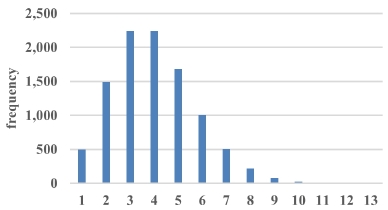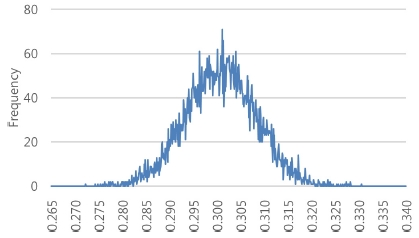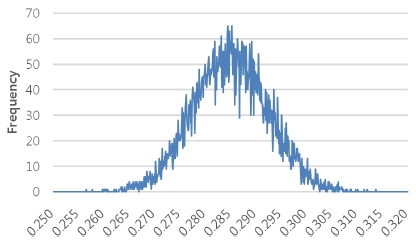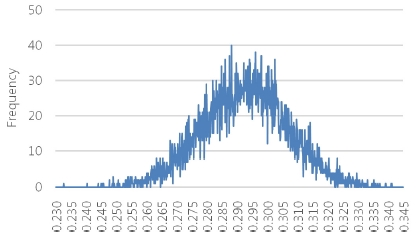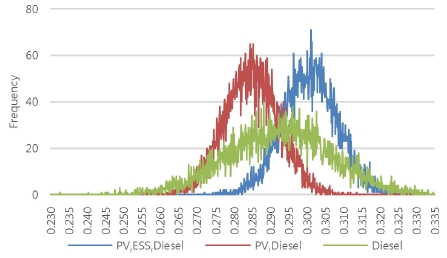
Risk Analysis for Optimal Independent Renewable Energy System
© 2018 by the New & Renewable Energy
This is an Open Access article distributed under the terms of the Creative Commons Attribution Non-Commercial License (http://creativecommons.org/licenses/by-nc/3.0) which permits unrestricted non-commercial use, distribution, and reproduction in any medium, provided the original work is properly cited.
Abstract
The deployment of renewable energy in off-grid systems is increasing steadily in both developed and developing countries. In particular, Small Island Developing States (SIDS) are keen to adopt renewable off-grid systems for power generation and transportation to reduce their heavy reliance on imported oil and fossil fuels. In addition, off-grid systems are deemed to be an important vehicle to boost the development of renewable-based grids because of their geographical constraints and costs for grid extension. With declining costs and increasing performance of solar photovoltaics (PV) as well as declining costs and technological improvements in electricity storage and control systems, adopting off-grid renewable energy systems could serve as an optimal option for SIDS to diversify the source of energy supply. In this respect, this paper identifies the most cost-efficient combination of renewable energy systems to assess the financial feasibility of the -grid renewable energy systems using HOMER. Moreover, based on @Risk simulations, uncertain factors, such as diesel cost, construction delays, and operating & maintenance (O&M) costs, will be considered to determine how those uncertainties in the future could affect the Levelized Cost of Energy (LCOE).
Keywords:
Renewable Energy, Hybrid Energy System, Off-grid System, LCOE, Climate Change Effects1. Introduction
Renewable energy is considered one of the most effective solutions to tackle climate change issues. According to the report by International Renewable Energy Agency (IRENA), renewables are expected to supply four-fifths of the world’s electricity by 2050, significantly reducing carbon emissions and contributing to mitigate climate change. But solar and wind power have to be fully integrated, with sustainable bioenergy being another key part of the mix.[1] As the importance of renewable energy grows, the renewable energy market has made remarkable progress, achieving a worldwide investment of $200 billion in 2017. In particular, the world installed more new solar power projects than the combined net additions of coal, gas and nuclear plants in 2017.[2]
Meanwhile, uncertainty in terms of the costs and benefits of renewable energy projects presents a tremendous challenge for business stakeholders and decision makers. The risks of implementing an investment project (IP) are often influenced by indefinite future events that can negatively impact the financial value of the investment projects.[3] Due to the prognostic nature of extensive data including financial, technological, legal, environmental and other types of information to be evaluated when making investment decisions, the risk model is deemed to be one of the most appropriate analytical methods to address the following relationships: returns, costs and risks in a cost-benefit framework.
In this regard, this paper aims to identify and assess the risk factors of renewable energy investment projects, especially in the case of deploying hybrid Photovoltaic (PV), diesel generator, and energy storage systems (ESS) in the Maldives. Using @RISK, we have identified and analyzed the investment risk factors of renewable energy sources from investors’ perspectives. Distinctive features of the paper are that it uses actual cost and technical information to examine the financial feasibility of a renewable project and incorporates the uncertainties in cost aspects.
In the literature, the application of off-grid renewable energy systems has been conducted in various researches. Sen and Bhattacharyya (2014) analyzed off-grid hybrid energy system for rural India by using HOMER software. The study found that the optimal off-grid system can become a cost-effective option compared to the grid extension.[4] Shahzad et al. (2017) found the optimized design of solar-biomass off grid system for a rural village in Pakistan. As Sen and Bhattacharyya (2014), the study also found that the hybrid system is a cost-effective system and argued that the government needs to provide additional supporting policies to employ the renewable systems in remote rural areas.[5] Lal and Raturi (2012) conducted the feasibility of hybrid renewable system in an island in Fiji. Similar to the case project in this paper, the project site is a remote island that the grid connection option cannot be applied. The study used scenario analysis to find the optimal energy system and found the hybrid renewable system is the most effective option. However, if the capacity shortage condition is accepted, a renewable energy system with energy storage can become the most optimal system configuration.[6] Bhattarai and Thompson (2016) examined the feasibility of the wind-diesel hybrid system in Brochet, Manitoba, Canada. The study found that the hybrid system can replace the existing system and had advantages in reducing the cost of electricity produced and carbon emissions.[7] Ghafoor and Munir (2015) demonstrated an economic and technical feasibility study of off-grid PV system for a single residential household in Pakistan. The study showed that off-grid solar home system could provide electricity at a lower unit cost compared to the conventional residential electricity supply.[8]
Also, the risks and risk management of renewable energy project have been examined in various studies. Monte Carlo simulation has been used to examine risk analysis and project assessment (Arnold and Yildiz, 2014; Hart and Jacobson, 2011; Pereira et al., 2014; Caralis et al., 2016; and Khindanova, 2013). Especially, Arnold and Yildiz (2014), Pereira et al. (2014) and Caralis et al. (2016) demonstrated how the Monte Carlo Simulation could be applied to renewable investment decision making. Arnold and Yildiz (2014) adopted Monte Carlo simulation to incorporate risk factors during the lifecycle of the renewable investment projects. The paper applied the probabilistic density function of the variables and demonstrated that the method could provide additional information to the investment decision making.[9] Pereira et al. (2014) conducted the risk assessment of a grid-connected, roof top solar project and a stand-alone PV system by using Monte Carlo simulation. The study demonstrated the distributions of energy cost for those systems based on the assumptions.[10] Caralis et al. (2016) analyzed 12 offshore wind farms and incorporated a wide range of uncertainties, such as technical, economic and regulatory uncertainties, into financial analysis. The study showed that the offshore wind farms require additional feed-in-tariffs to become economically feasible.[11]
Jung and Kim (2017) conducted the financial feasibility test of a hybrid PV-Diesel-ESS system in Kandooma Island, Maldives. The result of the financial simulation analysis based on 8 different scenarios of financial feasibility supported that a hybrid solar PV-diesel-ESS energy system is the most effective cost-effective off-grid energy system for the resort island.[12] This study only considered the pre-determined technical system and focused on the impact of financing setting on the financial feasibility. Moon and Jung (2017) analyzed how the project risk factors, including construction delays, affect the financial feasibility of a solar project in India by using a Monte Carlo simulation.[13] Khindanova (2013) incorporated the uncertainties in the electricity price and costs by establishing a deterministic model and used Monte Carlo simulation to evaluate a wind power generation investment.[14] Moreover, Turner et al. (2013) suggested risk management approaches for solar and wind energy projects, dividing risks facing renewable energy projects into four categories: construction, operation, market, and policy. It concluded that managing these risks will become increasingly important, as market risks, and also construction and operation risks, will generally increase.[15] Gatzert et al. (2015) investigated the case of onshore and offshore wind parks to conclude that diversification is one of the most important tools for risk management and it is used at various levels, which also results from a lack of alternative coverage. Furthermore, policy and regulatory risks appear to represent a major barrier for renewable energy investments, while simultaneously, insurance coverage or alternative risk mitigation is strongly limited. This emphasizes the need for new risk transfer solutions to ensure sustainable growth of renewable energy.[16] Industry studies include Watts (2011), who conducted a survey about the management of risks associated with renewable energy projects and found that insurance plays a primary role as a part of the risk mitigation strategies of senior executives. In addition, EWEA (2013) discusses key construction and operation risks for offshore wind parks including some risk mitigation strategies.[17] Various studies identified the risk factors in renewable systems and examined their impacts on the investments in renewable projects. Distinctive features of the paper are that it uses actual cost and technical information to examine the financial feasibility and incorporates the uncertainties in cost aspects.
2. Methodology and System Configurations
2.1 Technical Feasibility
HOMER (Hybrid Optimization of Multiple Electric Renewables), the energy modeling software, is used in this paper to assess the technical feasibility of off-grid power systems. Based on the input parameters, such as hourly and monthly load variations, as well as system costs, HOMER performs an hourly simulation of all possible component combinations entered and ranks the system configurations that satisfy the technical constraints at the lowest lifecycle cost. Hence, multiple optimizations under a range of input assumptions to measure the effects or changes in the model inputs could be examined.[18]
HOMER software provides two key functions: Simulation and Optimization. HOMER simulates numbers of system combinations by calculating their energy balances, finds whether the system is feasible, and estimates the costs of the systems. Then, HOMER searches the least-costly options and finds the optimal system configuration.[19]
2.2 Risk Simulation
In order to incorporate uncertainties in calculating LCOE, the paper uses @Risk Software, which is developed by Palisade Corporation. @Risk is an Excel-based software that performs analyses using a Monte Carlo Simulation. The software enables the ability to define and create the dataset distribution and run a Monte Carlo simulation. Variables have different probability distributions and provide different outcomes. This shows a range of possible outcomes, and the result shows uncertainties in a more realistic way.[20]
The paper establishes a model to calculate LCOE based on the system configuration and technical results from the HOMER software. Afterward, @Risk software is used to set distributions for three variables, which are Diesel price, Construction delay, and O&M cost, and runs the Monte Carlo simulation with 10,000 iterations to show how those variables affect the LCOE.
2.3 System Configurations
The paper establishes a case project to examine the impacts of three key variables on the LCOE of an off-grid solar project. The paper considers a resort hotel in Kandooma Island, the Maldives as the project site. The resort has been operating diesel generators to generate electricity and is considering shifting its generating technologies to sustainable energy options, such as PV-ESS-Diesel or PV-Diesel. The project plans to alter one existing diesel generator to solar PV and Energy Storage System and considers possible combinations of PV, Vanadium Redox Flow Battery (VRFB) 250 kWh by H2, Inc., and exiting 500 kw diesel generator to find the optimal system configuration providing the lowest LCOE by using HOMER software.
To establish an optimal system configuration, the paper uses the electric load pattern provided by the resort. As Kandooma Island is located in a tropical zone where cooling in buildings is essential, the electric load shows a relatively stable pattern with daytime peaks. As shown in Figure 1 and Figure 2, the monthly load shows a relatively stable pattern as well.
The cost information, including panel price and cost of ESS, is provided by WonGwang Electric Power Corporation and H2 Inc., respectively.
The project lifetime is 20 years. The system lifetimes of solar PV and VRFB are both 20 years, and only the inverter will be replaced every 10 years. Also, the diesel generator will be replaced after operating 60,000 hours. The paper collects the information required to calculate LCOE from the HOMER optimization results, (e.g. the annual electricity generation, diesel generator replacements, salvage values, etc.
To calculate LCOE, the paper assumes the inflation rate of 2.2%. Also, the paper assumes 70% of the capital costs is financed by debt and the remainder is raised by equity. The rates of return of Debt and Equity are 6% and 12.67%, respectively, and the debt is assumed to be amortized in 8 years.
Based on each technology’s load curve technical and cost information, HOMER software suggests the optimal system setting with the lowest COE. HOMER software suggests three different system settings as shown in Table 1. All systems assume using an existing 500 KW diesel generator, and the HOMER software provides the optimized capacity of PV and ESS.
HOMER Software simulates possible combinations of system components and finds the optimal systems with the lowest net present cost (NPC). HOMER software uses the equation below to calculate the total net present cost. Based on NPC, HOMER provides the ranks of the system configurations. CRF means the capital recovery factor, and Rlifetime indicates the project lifetime. Also, i indicates the annual real interest rate.[21]
The optimization suggests that the PV-ESS-Diesel system provides approximately 52% of the total electricity production from solar PV, and it enables the system to reduce diesel consumption. The HOMER software also suggests replacing the diesel generator in year 8 and year 16.
The PV-Diesel system provides approximately 53% of the total electricity from PV, but because there is no energy storage system, the PV-Diesel system wastes 27% of the electricity generated by PV annually as excess electricity. The system requires to replace the diesel generator in year 7 and year 14.
The diesel-only system, that satisfies the entire electric load by the existing diesel generator, produces 1,249,910 kWh every year, and the generator will be replaced in year 7 and year 14.
2.4 Key Risk Factors and Indicators
The key input parameters and their distributions are shown in Table 2. The paper assumes that the delay periods follow a Poisson distribution with Lambda of 3. Because the project location is Kandooma Island, Maldives, where the materials can be delivered only by ship, logistic issues can occur due to many different reasons, including weather conditions. Also, there are possibilities, such as administrative inefficiency and legal issues, that can delay the project deployment. According to the study by Moon and Jung (2017), the construction delay of solar projects is a prevalent issue in India, and the project delay negatively affects the financial performance of the project.[13] Thus, the project delay can be a major uncertainty that can change the LCOE of the project. The paper uses a Poisson distribution because the project delay does not happen simultaneously, and a delay of a project is independent to the delay of other projects. To include the negative financial impacts of project delay on LCOE, the paper assumes that the system pays additional interest payments and O&M costs (2% of the system cost per year) during the project delay periods. Due to all the systems using the existing diesel generator, there will be no project delay costs in the diesel-only case. In the study of Moon and Jung (2017), the project delay period in India is 3 ~ 6 months, in general. Since there is no study that examined the project delay periods in the Maldives, the study assumes that the project delay in the case project is three months, which is similar to the India case, and conducts sensitivity analysis on the delay periods.
Also, the paper assumes the diesel price follows normal distribution with a mean of $1.06/L and a standard deviation of $0.106/L. Generally, LCOE assumes a fixed diesel price for the entire project years or diesel prices with a fixed growth rate. However, the actual diesel price moves upwards or downwards according to the commodity market conditions. Thus, to incorporate the movement of diesel prices, the paper assumes the diesel price follows a normal distribution. Lastly, the paper incorporates uncertainties in Operation and Maintenance (O&M) costs. To maximize energy output and sustain the system operations, proper O&M should be implemented. During the project lifetime, events requiring additional repair, such as system damages, can occur, and it can further increase the project LCOE. To reflect this downward risk, the paper assumes a Chi-square distribution, which is positively skewed.
Levelized Cost of Energy (LCOE) is a method that is widely used to compare the competitiveness of different generating technologies.[22] LCOE is the annualized cost per kWh of electricity generated by the technology, and the cost includes capital costs, operating (Fuel, Operations and Maintenance) costs, and financing costs. Based on the information given from the HOMER simulation, the paper added the distributions to the key cost components and analyzed their impacts on LCOEs by using @Risk software.
3.1 Risk Analysis
Instead of using the COE calculated by HOMER, the paper builds a financial model that includes more financing and technical information, such as debt amortization and PV degradation to find a more realistic LCOE and to analyze how the risk factors affect LCOEs by using @Risk Software. The paper uses @Risk Software and iterates 10,000 simulations with three risk factors: project delay, diesel price, and O&M costs.
As the assumption, the project delay period follows a Poisson distribution with a lambda of 3 as shown in Figure 6. It suggests that a project can expect two or three months of project delay in general.
The simulation result shows that the average LCOE for the PV-ESS-Diesel system is $0.3009/kWh, and the distribution of LCOEs is shown in Figure 7. The LCOE range of the simulation is located between $0.2723/kWh and $0.3306/kWh. Including shipping, construction, and installation costs, the system requires about $1.3 million initially, and on average, an additional $16,371 is likely to be added as the delayed costs.
The simulation result shows that the average LCOE for the PV-Diesel system is $0.2850/kWh, and the distribution of LCOEs is shown in Figure 8. The LCOE range of the simulation is located between $0.2566/kWh and $0.3137/kWh. Including shipping, construction, and installation costs, the system requires about $1.14 million initially, and on average, an additional $15,938 is likely to be added as the delayed costs.
Unlike the previous PV-ESS-Diesel and PV-Diesel cases, the Diesel-only case is not affected by project delay but only affected by the movements of diesel price and diesel O&M. Also, the initial investment is not necessary because the system uses the existing diesel generator. The simulation result shows that the average LCOE for PV-Diesel system is $0.2927/kWh, and the distribution of LCOEs is shown in Figure 9. The LCOE range of the simulation is located between $0.2327/kWh and $0.3415/kWh. The diesel generation has the largest LCOE range because the diesel distribution is the most significant factor affecting the systems’ LCOEs.
3.2 LCOE Comparison
The simulation results show that the PV-Diesel system is likely to be the most cost-effective with an average LCOE of $0.2850/kWh, and the PV-ESS-Diesel system is likely to be the most expensive system as shown in Figure 10. On average, diesel generation is more expensive than a PV-Diesel system but cheaper than a PV-ESS-diesel system. However, diesel generation has the largest LCOE range, and the distribution of diesel generation overlaps LCOES of the other systems. Thus, it is not clear to conclude whether the PV-ESS-Diesel system or the PV-Diesel system is more cost-effective than the Diesel system.
The standard deviation of LCOE of diesel system is much higher than the other hybrid renewable systems. Since the electricity generated from PV and the use of energy storage system allow the renewable energy system to consume less diesel compared to diesel-only system. This made the LCOEs of the renewable systems less volatile. However, the study only considered the uncertainties of the cost aspects. If the intermittency and uncertainties in electricity generation from renewables are included, the standard deviation of LCOEs of the renewable systems can be expanded.
Though the project developers can benefit from panel and ESS price drops by delaying the procurement, the project delay eventually leads the project developers to increase expenses, such as additional interest payments and administrative costs, and raises LCOEs. Also, the assumption of O&M costs with the Chi-square distribution, which is positively skewed, tends to raise LCOEs Therefore, those two risk factors generally raise LCOEs.
For all systems, the most significant factor that affects LCOE is the changes in diesel prices. Though PV-ESS-Diesel and PV-Diesel systems utilize renewables sources, slightly over half of the electricity is generated from solar PV. Hence, diesel remains as an important source to generate electricity.
3.3 Sensitivity Analysis
The study conducts a sensitivity analysis that shows how project delay periods affect LCOEs of the systems by changing the value of Lambda for Poisson distributions. If the project delay month is longer (Lambda is larger), the average LCOE increases slightly as shown in Table 4 and Table 5. As the study assumes only O&M costs and interest payments occur during the project delay periods (few months), the delay does not significantly change LCOEs. However, in the real world, project delay can incur additional costs, such as legal settlements, storage costs, and other administrative costs, and increase the LCOEs of systems.
4. Conclusions
The study examines how risk factors affect LCOEs of off-grid renewable systems. Based on the electric load of a resort located in Kandooma Island, Maldives and the site’s solar radiation information, the study used the HOMER Software to find three different optimal system configurations with the lowest LCOEs. The study identified three key risk factors (project delay, operations and maintenance costs, and diesel prices) and assumed probabilistic distributions to incorporate risks into the LCOE analysis. Typical LCOE analyses only provide a single value, but the study provides ranges of LCOEs that support renewable providers to make risk-based investment decisions.
According to the HOMER Optimization, the PV (462 KW)-ESS (250 kWh)-Diesel (500 KW) and the PV (546 KW) – Diesel (500 KW) systems were selected as the optimal renewable settings, and those systems provide approximately 53% of the total electricity production.
The study shows that the PV-Diesel system has the lowest average LCOE of $0.2850/kWh while the PV-ESS-Diesel system has the highest average LCOE of $0.3009/kWh. The Diesel system’s average LCOE was $0.2927/kWh. The analysis shows that all systems have similar LCOEs on average. However, if the uncertainties were considered in the analysis, this result can be changed. The study found that the movement of diesel prices is the most significant risk factor affecting LCOEs of renewable systems, so the range of LCOEs can become larger if the system utilizes more diesel generation. Thus, the study found that the diesel system has the largest LCOE range and it can become the cheapest or the most expensive system as the diesel price changes. According to the result, using off-grid renewable systems can provide an opportunity to reduce uncertainties in LCOEs compared to the diesel-only system. Recently, the global oil price fluctuates significantly that the Brent Oil price reached $80 per barrel in September 2018 but became $60 in November 2018.[23] Encouraging renewable deployment can reduce the impacts of the fluctuation of global energy prices on a country’s domestic energy situations. Especially, this can be beneficial to countries with high oil dependence, such as the Maldives. The study conducted a sensitivity analysis by considering different project delay periods. As the study assumed a Poisson distribution for incorporating project delay risk, different Lambda values were used in the sensitivity analysis. In this study, only additional interest payments and O&M expenses were considered as the costs incurred during the delayed periods. Thus, changing the Lambda for the Poisson distribution slightly changes LCOEs, but the sensitivity analysis does not show significant changes in LCOEs.
Moreover, the government needs to support renewable providers by eliminating risk factors that can delay the project. Lacking information, such as local data, such as solar radiation and wind conditions, can mislead renewable providers to fail to make an optimal investment decision. Thus, establishing a publicly available information system that collects data and information can be a solution that helps renewable providers make optimal investment decisions. Also, the government should enhance its institutional capacity and make an efficient administrative process. This can reduce the time required to get permissions or settle local disputes.[13]
Acknowledgments
This work was supported by the Korea Institute of Energy Technology Evaluation and Planning (KETEP) and the Ministry of Trade, Industry & Energy (MOTIE) of the Republic of Korea (No. 20162010103860)
References
- International Renewable Energy Agency (IRENA), (2015), “Renewable Energy: A Key climate solution”, http://www.irena.org/climatechange/Renewable-Energy-Key-climate-solution.
- United Nations Environmental Programme, (2018), “Global Trends in Renewable Energy Investment 2018”, Frankfurt School of Finance & Management, Germany, http://fs-unep-centre.org/sites/default/files/publications/gtr2018v2.pdf.
-
Vidmantas Jankauskas, Paulius Fudzkis, Adomas Kanopka, (2014), “Risk factors for stakeholders in renewable energy investments”, energetika, 60(2), p113-124.
[https://doi.org/10.6001/energetika.v60i2.2935]

-
Sen, Rohit, Bhattacharyya, Subhes C., (2014), “Off-grid electricity generation with renewable energy technologies in India: An application of HOMER”, Renewable Energy, 62, p388-398.
[https://doi.org/10.1016/j.renene.2013.07.028]

-
Shahzad, M. Kashif, Zahid, Adeem, Rashid, Tanzeel ur, Rehan, Mirza Abdullah, Ali, Muzaffar, Ahmad, Mueen, (2017), “Techno-economic feasibility analysis of a solar-biomass off grid system for the electrification of remote rural areas in Pakistan using HOMER software”, Renewable Energy, 106, p264-273.
[https://doi.org/10.1016/j.renene.2017.01.033]

-
Lal, Sandeep, Raturi, Atul, (2012), “Techno-economic analysis of a hybrid mini-grid system for Fiji Islands”, International Journal of Energy and Environment Engineering, 3, p10.
[https://doi.org/10.1186/2251-6832-3-10]

-
Bhattarai, Prasid Ram, Thompson, Shirley, (2016), “Optimizing an off-grid electrical system in Brochet, Manitoba, Canada”, Renewable and Sustainable Energy Reviews, 53, p709-719.
[https://doi.org/10.1016/j.rser.2015.09.001]

-
Ghafoor, Abdul, Munir, Anjum, (2015), “Design and economics analysis of an off-grid PV system for household electrification”, Renewable and Sustainable Energy Reviews, 42, p496-502.
[https://doi.org/10.1016/j.rser.2014.10.012]

-
Arnold, Uwe, Yildiz, Ozgur, (2015), “Economic risk analysis of decentralized renewable energy infrastructures - A Monte Carlo simulation approach”, Renewable Energy, 77, p227-239.
[https://doi.org/10.1016/j.renene.2014.11.059]

-
Pereira, Edinaldo Jose da Silva, Pinho, Joao Tavares, Galhardo, Marcos Andre Barros, Macedo, Wilson Negrao, (2014), “Methodology of risk analysis by Monte Carlo Method applied to power generation with renewable energy”, Renewable Energy, 69, p347-355.
[https://doi.org/10.1016/j.renene.2014.03.054]

- Caralis, George, Chaviaropoulos, Panagiotis, Albacete, Virginia Ruiz, Diakoulaki, Danae, Kotroni, Vassiliki, Lagouvardos, Konstantinos, Gao, Zhiqui, Zervos, Arthouros, Rados, Kostas, “Lessons learnt from the evaluation of the feed-in tariff scheme for offshore wind farms in Greece using a Monte Carlo approach”, Journal of Wind Engineering and Industrial Aerodynamics, 157, p63-75.
- Jung, Tae Yong, Kim, Donghun, (2017), “A Solar Energy System with Energy Storage System for Kandooma Island, Maldives”, Korean Energy Economic Review, 16(2).
- Moon, Jongwoo, Jung, Tae Yong, (2017), “Incorporating uncertainty in analyzing the financial feasibility of solar project in India”, Korea and the World Economy, 18(3), p259-280.
- Khindanova, Irina, (2013), “A Monte Carlo model of a wind power generation investment”, Journal of Applied Business and Economics, 15(1), p94-106.
- Guy Turner, Sam Roots, Michael Wiltshire, Juerg Treub, Stuart Brown, Guido Benz, Martin Hegelbach, (2013), “Profiling the risks in solar and wind”, Swiss Re Ltd, 10.
-
Nadine Gatzert, Thomas Kosub, (2015), “Risk and Risk Management of Renewable Energy Projects: The Case of Onshore and Offshore Wind Parks”, Actuaries Institute.
[https://doi.org/10.1016/j.rser.2016.01.103]

- European Wind Energy Association, (2013), “Where’s the Money Coming From? Financing Offishore Wind Farms”, http://www.ewea.org/fileadmin/files/library/publications/reports/Financing_Offshore_Wind_Farms.pdf.
- U. Sureshkumar, P.S. Manoharan, A.P.S. Ramalakshmi, (2012), “Economic Cost Analysis of Hybrid Renewable Energy System using HOMER”, IEEE.
- HOMER Pro Version 3.11 Manual, (2017), HOMER® Energy, https://www.homerenergy.com/products/pro/docs/3.11/index.html.
- Palisade Software, (n.d.), “@Risk for Risk Analysis”, http://www.palisade.com/risk/.
- Lambert, Tom, Gilman, Paul, Lilienthal, Peter, (2006), “Micropower system modeling with HOMER”, Integration Alternative Sources Energy, 1, p379-418.
- U.S. Energy Information Administration, (2018), “Levelized cost and levelized avoided cost of new generation resources in the Annual Energy Outlook 2018”, https://www.eia.gov/outlooks/aeo/pdf/electricity_generation.pdf.
- Bloomberg, (n.d.), “Crude Oil and Natural Gas”, Available at: https://www.bloomberg.com/energy (accessed on 22 November 2018).
-
Kim, Haneol, Park, Jingyu, Lee, Sangnam, and Kim, Jongkyu, (2016), “Performance Evaluation and Economic Estimation of LFR Solar Thermal Power and Photovoltaic”, New and Renewable Energy, 12(4), p105-113.
[https://doi.org/10.7849/ksnre.2016.12.12.4.105]

-
Kim, Youngkyung, and Chang, Byungman, (2012), “Estimation of LCOE for Korean PV projects: For the ones that financial investors participated in”, New and Renewable Energy, 8(3), p23-29.
[https://doi.org/10.7849/ksnre.2012.8.3.023]


